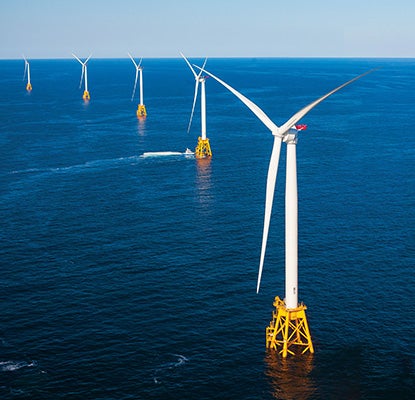Offshore wind turbines with a fixed foundation built into the seafloor, like those constructed off Block Island, are not economical in water more than 200 feet deep. A new system of floating turbines is now in development that would allow for electricity generation in deeper water farther offshore where winds are more favorable.
To optimize the operation of floating offshore wind turbines, a team of University of Rhode Island engineers – along with colleagues at the University of Maine – has been awarded a $1.245 million grant by the Department of Energy to model and test a system for controlling the motion of the floating structures. The grant, entitled “Design, optimization, and control of floating offshore wind farms for optimal energy production,” was funded through the department’s Established Program to Stimulate Competitive Research (EPSCoR) program.
“This federal grant is good news for URI and will help boost the state’s research capacity in renewable energy and energy utilization. I hope this research will help spur advances in ocean engineering and ultimately enhance the way we manage offshore wind energy,” said Senator Reed, who noted that URI was among nine projects nationwide that received a share of EPSCOR funding from this round of grants that focused on energy research topics, including solar energy, wind energy, and advanced manufacturing.
“The University of Rhode Island is doing exciting research on the development of floating offshore wind turbines,” said U.S. Senator Sheldon Whitehouse. “The biggest challenge to getting offshore wind farms up and running is the siting process, which includes balancing the complex needs of different ocean users. If we can locate floating turbines farther out to sea, we could rapidly scale up offshore wind and get more clean, reliable energy on the grid.”
According to Stephan Grilli, the URI professor of ocean engineering who leads the project, the uncertainties and irregularities of ocean waves and other marine factors are major challenges to the development of commercial-scale floating wind turbines. Their operation can lead to unpredictable forces on the structure, leading to fatigue and reduced operational life.
“These are top-heavy structures, and when a floating turbine is leaning due to the waves, it has more forces bending the turbine structure, which also affects the wind power capture,” said Grilli. “Those repetitive movements cause fatigue on the whole structure and lead to a shortened lifespan.”
To optimize control of the turbines requires a method of anticipating the movement of the floating structures, and to do that requires real-time information about approaching waves.
“No one is using that information yet; they just use the past movement of the float,” Grilli said. “We’ve worked for 10 years on sensing ocean waves using LIDAR, a remote sensing method using lasers, so we can acquire a lot of information on the position of approaching waves almost instantaneously.
Using what Grilli calls digital twins – computational models that operate in parallel with scale models of actual floating turbines – the researchers will be able to anticipate the forces the structures will face from moment to moment and predict their behavior, which will help to control the system.
“We’ll be running the model in real time at the same time as sensing the waves and providing information to the controller so the controller can do its job,” explained Grilli. “All of that requires a lot of computational power.”
Controlling the system in this way is a key factor in the future commercialization of offshore floating wind turbines, which are not yet in operation in any significant way anywhere around the world. If this technology were ready to be deployed, offshore wind farms being considered for development off the U.S. East Coast could be extended into deeper waters farther from shore, thereby reducing conflict with other ocean users.
In addition to Grilli, other URI researchers involved in the project include ocean engineering professors Jason Dahl, Annette Grilli and Reza Hashemi. The University of Maine team is led by Richard Kimball, professor of mechanical engineering.
The project has received numerous endorsements from local industries and agencies, including Raytheon and the Naval Undersea Warfare Center.

